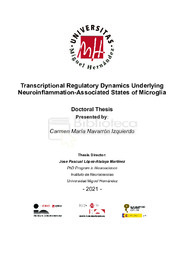Por favor, use este identificador para citar o enlazar este ítem:
https://hdl.handle.net/11000/29289Registro completo de metadatos
| Campo DC | Valor | Lengua/Idioma |
|---|---|---|
| dc.contributor.advisor | López-Atalaya Martínez, José Pascual | - |
| dc.contributor.author | Navarrón Izquierdo, Carmen María | - |
| dc.contributor.other | Instituto de Neurociencias | es_ES |
| dc.date.accessioned | 2023-06-06T12:41:30Z | - |
| dc.date.available | 2023-06-06T12:41:30Z | - |
| dc.date.created | 2021-10-01 | - |
| dc.identifier.ismn | 1743 | - |
| dc.identifier.uri | https://hdl.handle.net/11000/29289 | - |
| dc.description.abstract | Microglia heterogeneity has been shown in both healthy and chronic neurodegenerative conditions, however, very little is known about microglia chromatin accessibility and transcriptome landscape during acute neuroinflammation. We combined bulk RNAsequencing and ATAC-sequencing on FACS-sorted microglia population with single molecule in situ hybridization (RNAscope), to reveal dynamic transitions across microglia functional states along the acute neuroinflammatory response. We identify an immediateearly cytokine-related (Il1b) and an immediate-sustained interferon response (Oasl2) microglia; a delayed response associated to heterogeneous proliferative microglia (Ms4a4a); and a delayed-sustained late stage of MHC-II-expressing (Axl) microglia; altogether with a transient loss of homeostatic genes (P2ry12, Cx3cr1 among others). Meta-analysis of published DAM microglia marker genes and LPS-responsive microglia shows that late stage of acute inflammation-associated microglia shares DAM phenotype. We confirm the presence of DAM and IRM microglia by microglia single-cell RNA-sequencing of J20 mouse model of AD. Moreover, we identify in situ by RNAscope of common acute and chronic neuroinflammation marker genes, a specific upregulation of the interferon-related marker (Oasl2) in the proximity of diffuse Aβ plaques whereas the phagocytic-related marker (Axl) is expressed by microglia in the surrounding of both dense and diffuse Aβ plaques. We also revealed an increase in the expression of both Oasl2 and Axl in human postmortem brain tissue from AD patients. Finally, in silico transcription factor motif analysis shows the RelA/p65 subunit of the transcription factor NF-κB as a key regulator of microglia cytokine-related transcriptional program. Conditional depletion of RelA in microglia during adulthood (RelA-cKO mice) recapitulates the interferon-related (with upregulation of Oas family) and phagocytic microglia phenotypes (with an upregulation of Axl) that is sufficient to alter instrumental learning and memory, and LTP. Our findings reveal common microglia signatures in acute (LPS) and chronic (AD) inflammatory conditions both in mouse animal models and human AD. Depletion of RelA reprograms microglia towards a phenotype present in both the late state in acute LPS, and Aβ plaques-associated microglia in chronic disease. Our work deepens our knowledge of microglia heterogeneity in acute and chronic neuroinflammatory response, with major implications for our understanding of microglia contributions to disease. | es_ES |
| dc.format | application/pdf | es_ES |
| dc.format.extent | 199 | es_ES |
| dc.language.iso | eng | es_ES |
| dc.publisher | Universidad Miguel Hernández de Elche | es_ES |
| dc.rights | info:eu-repo/semantics/openAccess | es_ES |
| dc.rights.uri | http://creativecommons.org/licenses/by-nc-nd/4.0/ | * |
| dc.subject | Neurociencias | es_ES |
| dc.subject.other | CDU::6 - Ciencias aplicadas::61 - Medicina::616 - Patología. Medicina clínica. Oncología::616.8 - Neurología. Neuropatología. Sistema nervioso | es_ES |
| dc.title | Transcriptional regulatory dynamics underlying neuroinflammation-associated states of microglia | es_ES |
| dc.type | info:eu-repo/semantics/doctoralThesis | es_ES |

Ver/Abrir:
TD. Navarron Izquierdo, Carmen María.pdf
45,87 MB
Adobe PDF
Compartir:
 La licencia se describe como: Atribución-NonComercial-NoDerivada 4.0 Internacional.
La licencia se describe como: Atribución-NonComercial-NoDerivada 4.0 Internacional.
.png)